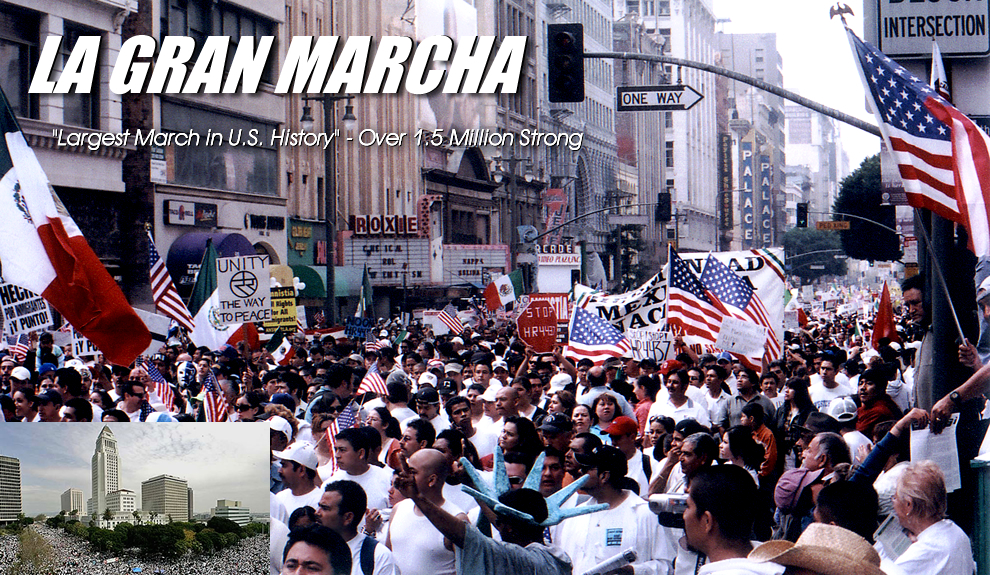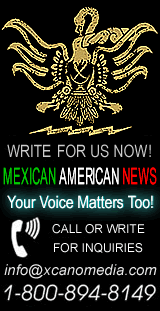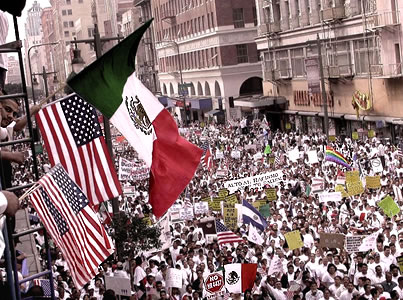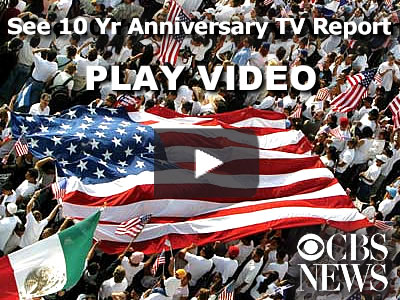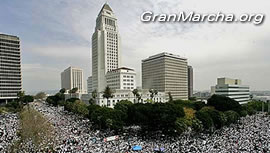


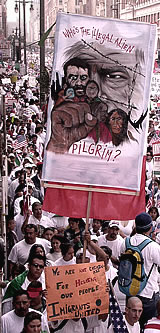

LA GRAN MARCHA - LARGEST SINGLE EVENT MASS PROTEST IN U.S. HISTORY
The Uprising That Defeated H.R. 4437 (aka "Border Protection, Antiterrorism, and Illegal Immigration Act of 2005")
On March 25th, 2006, the largest 'ever' public protest in the history of the United States occurred in the streets of downtown Los Angeles.
With a crowd estimated to be well over 1.5 million demonstrators, what's commonly known as "La Gran Marcha" (English translation "The Great March") propelled the U.S. Latino community from often being referred to as the "Sleeping Giant", to a position of internal self-awareness and outward public recognition that up until this moment in U.S. history had not been realized before.
The Magnitude Of This Event Is Unparralled In U.S. History
As of this writing, it has been exactly 16 years to the day since the passing of this historic event. In just two years, it will be the 20th year anniversary of La Gran Marcha. Yet, surprisingly, most citizens of the U.S. have never heard of it before. The obvious questions are: Why? Why not? Why is this so-called "largest mass protest demonstration" in all of the history of the United States so utterly unknown?
The significance of this question can't be overemphasized. Anyone can speculate. And, in the course of questioning this issue for the past 16 years, many have. But, the salient point always remains. This was largest single assembly of people ever gathered at any one location at one time in all U.S. history. Yet, it was virtually ignored by all of the major (English language) U.S. mainstream TV networks.
The English language newspapers and periodicals didn't fare much better. Even the Los Angeles Times that witnessed La Gran Marcha at their front door when its building was located in downtown L.A., has not given any significant follow-up coverage to this historic event. This is especially egregious since they have been made aware that their 2006 reporting of the LAPD's tremendously bad estimate of 500 thousand. In the past 16 years, both photographs and aerial footage examined have repeatedly confirmed that the actual crowd count of La Gran Marcha (also affectionately referred to as "The Great March" by those who attended) is much closer to 1.5 million people assembled. This calcualtion is three times larger than the reported LAPD estimate and was arrived at through the efforts of three independent and prestigious institutions. Both faculty and students from San Jose State University, St. Mary's University, and the University of Texas at Austin were all involved. Aside from some occassional local TV coverage given from a municipal perspective, The Great March of 2006 and the many subsequent demonstration which followed were for the most part totally ignored by all national U.S. mainstream media. To date, Mexican American News has made a concerted effort to gather all of the existing U.S. national news reportage on the event. This sustained effort has resulted in a compilation of only 14 minutes and 40 seconds of footage in total. This survey comprised all the major national news channels including both cable and the traditional broadcasting networks.
Not until the recent Black Lives Matter protests subsequent to the George Floyd shooting of 2020 had our country ever witnessed anything similar to the sustained multitude of marches that occured in the Spring of 2006. When compared, the major difference between these two sustained series of demonstrations is that whereas the BLM protests will absolutely assuredly be given major continual national news coverage; the protest marches in Spring of 2006 were overwhelmingly attended by U.S. Latinos and viewed as a Latino community only issue and often relegated to coverage by Spanish language media alone. This type of scenario is commonly observed and continually seen by members of the U.S. Latino community as an obvious statement on the differences in power held when comparing the black and Latino communities. It is generally viewed within the U.S. Latino community that the U.S. national dialogue is one which emphasizes a white and black community narrtive only. More so, the talking points when reporting on the U.S. Latino community is commonly seen as simpleton one-sided with an emphasis on fear-mongering as exemplified by the continual reportage concering illegal immigration and border security.
For those who attended La Gran Marcha/The Great March of 2006, one of the most remarkable things remembered is how peaceful it was. Not one arrest was made in the crowd of over over 1.5 million gathered. When discussing the spectacle with one of the organizers, Chief William Bratton of the L.A.P.D. was quoted as saying, "I've never seen anything so large like this. What's most incredible is how peaceful it is." In the photographs seen of this day, it is easily noticed how many people intentionally wore white t-shirts to show a statement of peace.
Who Were The Masses That Gathered For La Gran Marcha? What Were They Protesting? How Was It Organized?

As one of the many marchers who witnessed the enormity of this unprecedented day, I can assure you of this. This was no little undertaking. Like most things of tremendous magnitude, significance, and success, there were a great many people involved who were all equally important in the creation of this tremendous spectacle event. Unfortunately, it's literally impossible to name all of them here in such limited space. As is often the case, so many go unrecognized in the annals of history. It starts from the very bottom and continues to the top. It doesn't matter if one spent their time making posters, banners, putting in hours with other organizers, activists, union leaders, a radio personality, a webmaster, nonprofit organization, religious institution, online bloggers, smartphone users, or simply showed up. All of these individuals and entities were equal in their importance. Truly this was a massive grass roots U.S. Latino community demonstration of solid cohesion, purpose, and self-empowerment through the display of true unity.
What matters most when contemplating the importance of La Gran Marcha is the significance of what it immediately accomplished and the direct effects of what has occured in subsequent years as a result. So what was the primary purpose of La Gran Marcha? It came about to defeat a U.S. Congressional threat.
La Gran Marcha was a reaction to HR 4437, a bill introduced in the House of Representative of the 109th Congress, also known as the "Border Protection, Antiterrorism, and Illegal Immigration Act of 2005". Authored by Republicans, Jim Sensenbrenner of Wisconsin and Peter King of New York, it passed the United States House of Representatives on December 16, 2005 by a vote of 239 to 182 (with 92% of Republicans supporting it and 82% of the Democrats opposing). HR 4437 was then on its way to being voted on by the Republican controlled Senate which had then been giving signs of following a path similar to that of the House. Although often perceived as very sympathetic to immigrants, President George Bush Jr., a Republican, was being pressured by his party to not veto the bill if on his desk.
The primary points of contention for the marchers and all of us who fought to defeat HR 4437 were these. If HR 4437 was to have become law, the following would have happened within days of passage: 1) immediately turned an estimated 11 million undocumented immigrants from being misdemeanor offenders into the categorization of hardcore criminal felony offenders; 2) charged "any" person who knowingly aides an undocumented person to remain in the U.S. ( without their proper documentation already approved and in good standing order ) to be guilty of criminal “smuggling” -- this would have included those of the clergy, nonprofit sectors, and even the medical professions; 3) required local law enforcement to act as federal immigration agents; 4) required the construction of a complete southern border barrier in the form of a wall and/or fence with Mexico, while leaving the northern border with Canada to remain virtually open; 5) required the creation of a new employment verification system with "a unified database to be maintained by the Department of Homeland Security and comprised of data from the Social Security Administration" -- this also necessitated that every inhabitant of this country who would be seeking legal employment be required to carry a new type of social security card "made of a durable plastic" that "include an encrypted machine-readable electronic identification strip" or chip that "be issued to each individual (whether or not a U.S. citizen)." In addition to these five main commonly mentioned statutes, there were also some other extreme provisions less commonly known that even Nazi Germany of the 1940s did not enact. Sound extreme? Hear this. Homeland Security was being given the authority to act solely "without judicial review."
One of the the most remarkable things of La Gran Marcha is not only was it the largest U.S. demonstration. It was thereby also the most peaceful. The L.A.P.D. didn't report on even one arrest. This day should literally be included in the curriculum of every U.S. history classroom. For now, lets just see how many in the mainstream U.S. news media will care to report on the information seen in this page.

